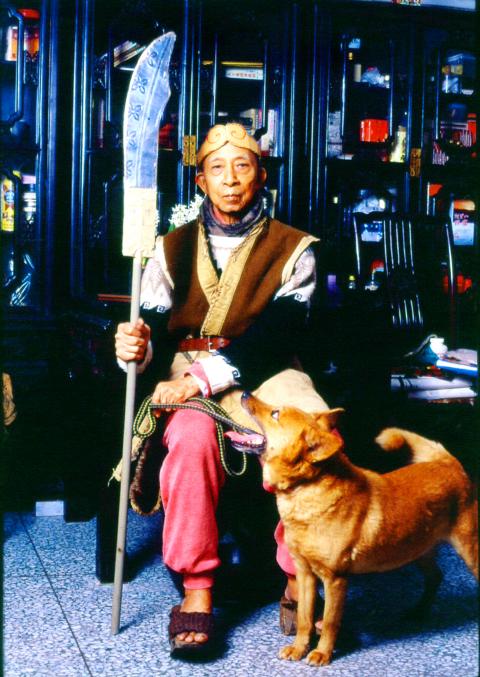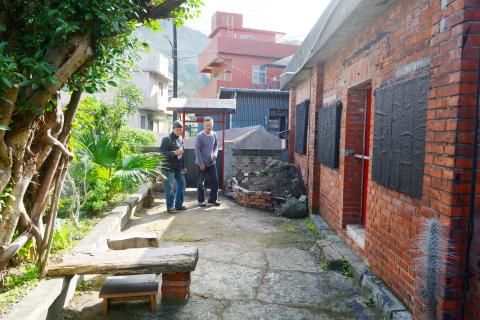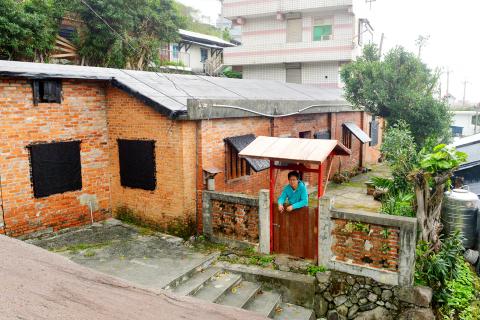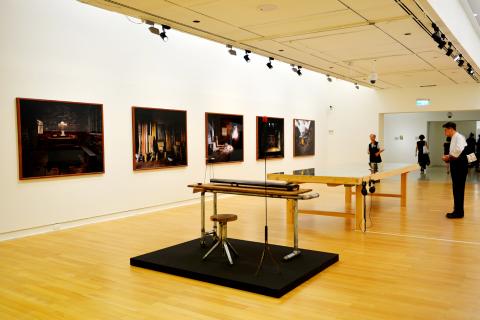Yeh Wei-li (葉偉立) is known for his attraction to ruins, rubbish and discarded objects. The photographer is taking a different approach in his current project, however, which is to preserve the body of work that legendary artist Yeh Shih-chiang (葉世強) left behind, and renovate the artist’s home.
Yeh Wei-li worked for months in 2015 to clear the tropical vegetation that had invaded the red-brick farm in Wantan Village (灣潭) in New Taipei City’s Sindian District (新店) where Yeh Shih-chiang lived between 1978 and 1989, and is now renovating a second house in Shueinandong area (水湳洞) in Rueifang District (瑞芳) where the painter lived as a recluse between 1989 and 1995, documenting the entire process on film.
This is the story Yeh Wei-li presents in his hybrid installation on the second floor of the Taipei Fine Arts Museum, as part of the 2016 Taipei Biennial.

Photo courtesy of the Yeh Shih-chiang Memorial Foundation
Curated by Corinne Diserens, the biennial is offering much food for thought around the general theme of archives and the role of the artist in society, either as a witness and an amplifier or as a direct driver of events.
MINI MUSEUM
The installation functions as a mini museum dedicated to the art and life of Yeh Shih-chiang, who passed away in 2012 at the age of 86. Two monumental oil paintings, one tiny drawing on a huge blank canvas, a guqin (a seven-string plucked instrument) and a candle stand, all created by the late master, are displayed next to some of his tools. These artworks share the space with Yeh Wei-li’s photographs and films.

Photos courtesy of Yeh Wei-li
Set in an eerie environment a slingshot away from abandoned gold mines, the Shueinandong house, with its tar-covered roof and heavy wooden shutters, has a distinctive charm that surely Yeh Shih-chiang recognized instantly.
“What I am working on here will be permanent with the opening of a museum run by the Yeh Shih-chiang Memorial Foundation,” he said.
Yeh Wei-li has been renovating the Shueinandong house with his wife Wu Yu-hsin (吳語心) and an assistant, trying to respect Yeh’s artistic choices and way of life.

Photos courtesy of Yeh Wei-li
The photographer never met the old painter.
Yeh Wei-li saved what he could of the wooden furniture and gutted the Japanese-style tatami room because it had been invaded by termites. To reconstruct shelves and other structures, he uses recycled wooden planks that the painter had collected.
The kitchen with its antique stone sink still retains odd-looking utensils handmade by the painter himself. Yeh Wei-li has carefully preserved telephone numbers and notes chalked by the old Yeh next to the door. He is still undecided about what to do with the pockmarks on the earthen wall.

Photos courtesy of Yeh Wei-li
“In Wantan, I wanted to bring back guqin music to the house,” he says of the elder artist, who was also a respected guqin craftsman.
In 2015, Hong Kong’s Hanart TZ Gallery founder Chang Tsong-zong (張頌仁) commissioned Yeh Wei-li to create an “interpretive” body of work inspired by Yeh Shih-chiang’s art. The result of this “collaboration” was exhibited at the Hong Kong Arts Centre in November of that year.
Why Hong Kong? Born in Guangdong, Yeh Shih-chiang could be considered a Cantonese artist, although he settled in Taiwan in 1949 at the age of 26. But the real reason is, Chang Tsong-zong was perhaps the only art dealer the old painter ever trusted.
ECCENTRIC ARTIST
The eccentric Yeh Shih-chiang was something of a legend for refusing to sell any of his works — with the exception of his guqin. The words “not for sale” are famously written on the back of each of his canvases. Indeed, he didn’t like to show them at all, and held very few exhibitions in his lifetime.
Restoring Yeh’s dwellings to a semblance of life is only the first step: Most important is to classify, restore and digitize the enormous body of work left behind by the painter. Yeh Wei-li has counted exactly 58 oil paintings of the same scale, 217 by 414 cm, give or take a centimeter, none of which are stretched or framed. There are also smaller formats. Most of them are badly damaged and very fragile. Add five or six thousand large works on paper, mostly calligraphy, and you get an idea of the scale of the challenge.
“He would probably hate me,” quips the photographer when asked how Yeh Shih-chiang would feel about his project. He knows that the facetious old painter was temperamental: usually displaying a zen-like attitude, he could at times be ferocious, “especially with untalented students like me.”
Yeh Wei-li and his wife relish the opportunity of taking part, so to speak, in the creation of Yeh Shi-chiang’s history. “We can see from the inside how it is growing. He is definitely one of the best abstract artists of his time, yet there are so few writings about him.”
That is why, Yeh says, the Taipei Biennial’s curator insisted on hanging works by Taiwanese Hung Yi-chen (洪藝真) and American Ad Reinhardt next to his installation. “She framed Yeh Shih-chiang with these two very important abstract artists.”
Yeh Wei-li doesn’t see his present occupation as keeping him away from his own art. “I am not sacrificing myself... It’s a situation, a condition. I came here because of Yeh Shih-chiang but there are lots of things that interest me around here. I am gathering material for my own work.”

May 18 to May 24 Pastor Yang Hsu’s (楊煦) congregation was shocked upon seeing the land he chose to build his orphanage. It was surrounded by mountains on three sides, and the only way to access it was to cross a river by foot. The soil was poor due to runoff, and large rocks strewn across the plot prevented much from growing. In addition, there was no running water or electricity. But it was all Yang could afford. He and his Indigenous Atayal wife Lin Feng-ying (林鳳英) had already been caring for 24 orphans in their home, and they were in

President William Lai (賴清德) yesterday delivered an address marking the first anniversary of his presidency. In the speech, Lai affirmed Taiwan’s global role in technology, trade and security. He announced economic and national security initiatives, and emphasized democratic values and cross-party cooperation. The following is the full text of his speech: Yesterday, outside of Beida Elementary School in New Taipei City’s Sanxia District (三峽), there was a major traffic accident that, sadly, claimed several lives and resulted in multiple injuries. The Executive Yuan immediately formed a task force, and last night I personally visited the victims in hospital. Central government agencies and the

Australia’s ABC last week published a piece on the recall campaign. The article emphasized the divisions in Taiwanese society and blamed the recall for worsening them. It quotes a supporter of the Taiwan People’s Party (TPP) as saying “I’m 43 years old, born and raised here, and I’ve never seen the country this divided in my entire life.” Apparently, as an adult, she slept through the post-election violence in 2000 and 2004 by the Chinese Nationalist Party (KMT), the veiled coup threats by the military when Chen Shui-bian (陳水扁) became president, the 2006 Red Shirt protests against him ginned up by

As with most of northern Thailand’s Chinese Nationalist Party (KMT) settlements, the village of Arunothai was only given a Thai name once the Thai government began in the 1970s to assert control over the border region and initiate a decades-long process of political integration. The village’s original name, bestowed by its Yunnanese founders when they first settled the valley in the late 1960s, was a Chinese name, Dagudi (大谷地), which literally translates as “a place for threshing rice.” At that time, these village founders did not know how permanent their settlement would be. Most of Arunothai’s first generation were soldiers